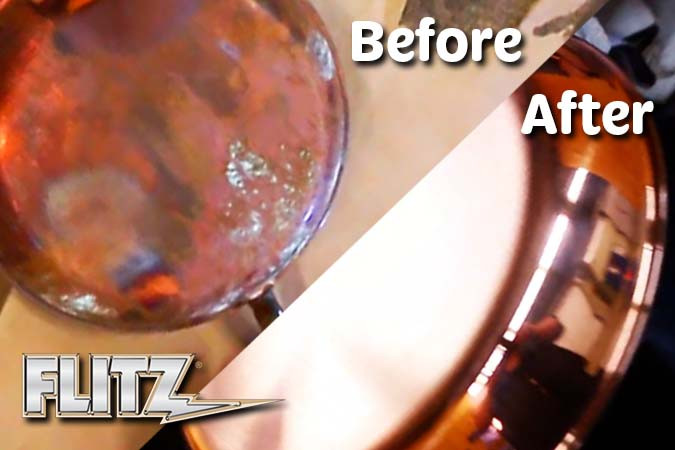You Ruined My Copper Sink & Cookware! – Copper Polishing & Tarnish Removal
Posted by Flitz International on 16th Sep 2022
There’s nothing quite like the look of elegant copper cookware. Not only is it the preferred cookware for classically trained French chefs, but it also is unsurpassed in heat transfer and a number of other culinary preferences. Did you know that a copper bowl is the single best container to whip egg whites in? There’s something about egg whites and copper that yields amazing results. The problem with copper is that it tarnishes quickly and can be a bear to clean. The same holds true for today’s modern, and usually very expensive, copper designer sinks. The other day, a customer contacted us and asserted that our products had completely ruined her copper cookware. It’s a good story. More on that later.
Why is keeping copper clean so hard?
As far as metals on the periodic table go, Copper (Cu) is one that really loves to interact with good old oxygen (O 2). Left to its own devices, untreated copper will quickly go from pinkish/red to dark red to brown and eventually to that blue/green color we’re all familiar with. (You’d be surprised how many people have no idea that the Statue of Liberty’s exterior is made of copper.) As long as copper is untreated, there really isn’t anything you can do to stop that tarnishing. That’s why your copper sinks and cookware get dark and unpleasant looking so fast – There’s literally nothing to stop the air from interacting with the raw copper.
So how do I clean copper?
Good question. Vinegar, baking soda, ketchup, you name it, there’s home remedy versions of copper cleaning using all kinds of ingredients. Funny thing; Most of them actually work, eventually. It comes down to how much shenanigans and home chemistry you have the time and patience for. Things like vinegar, ketchup, and most industrial cleaners use acid in one form or another, and in varying strengths. It’s the acid that does the number on the tarnish. If the acid is strong enough, it should remove the tarnish down to the bare metal. And there’s where things can get dicey: strong acid. Anytime you see those two words together, you’ve got to be careful. Very careful. So… acid; potentially dangerous but usually very effective.
What else can I use to remove tarnish besides something acid-based?
Flitz Instant Brass & Copper Tarnish Remover is an organic-salts based tarnish remover. The spray-on and rinse-off product is completely neutralized with the water rinse, making it easier and safer to use than traditional acids. Plus, cookware notwithstanding, there are decorative copper locations where ketchup just isn’t an option.
Now back to our “ruined cookware” story…
It turns out that our well-intentioned customer and her cookware that we allegedly “ruined” simply just didn’t understand copper and how to clean it. Like lots of folks, she thought that the tarnish remover was like Pledge furniture polish. Spray it on, wipe it off, and done. When it comes to tarnish removal, it’s a two-step process. Once you use you use our Flitz Instant Brass & Copper Tarnish Remover you’re now down to the bare (and extremely reactive) copper. At this point you must still polish and protect the copper or it will begin to tarnish again fairly quickly.
We tried to convey this to our customer, but she was convinced we had trashed her cookware. Sooo… we asked her to send one of the pieces of damaged cookware to us on our dime. It arrived a few days later and it was exactly as we suspected. She had removed the tarnish, but the copper was left unprotected and it indeed looked terrible.
Flitz Polish to the rescue!
To make a long story short; A quick reapplication of our tarnish remover, followed by Flitz Polish and some buffing and the cookware looks as good as new. Success! Remember, when it comes to tarnish removal on copper, brass, bronze, in fact almost every metal, first remove the tarnish, then polish/protect the metal to fend off future tarnish.
Also remember that we’re always here to help. If you’ve got questions, drop a note to info@flitz.com and we’ll be happy to assist!


